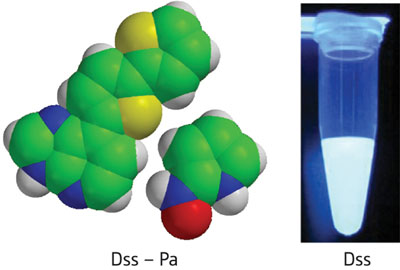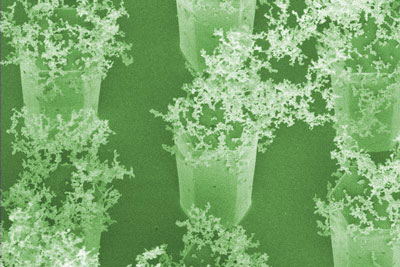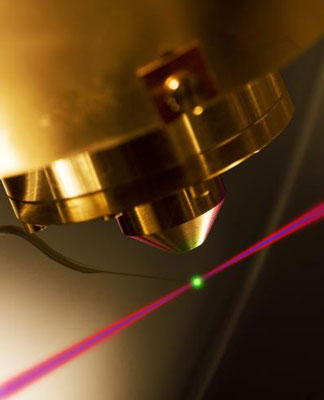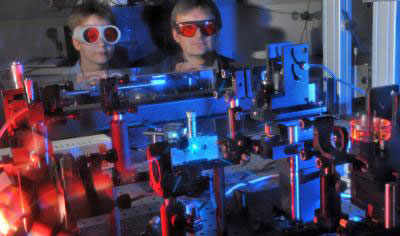A cluster of carbon nanotubes coated with a thin layer of protein-recognizing polymer form a biosensor capable of using electrochemical signals to detect minute amounts of proteins, which could provide a crucial new diagnostic tool for the detection of a range of illnesses.
Jun 27th, 2010
Read more
Winners to receive 1-year MEMS design software license and chance to publish research.
Jun 27th, 2010
Read more
Here is another installment of our collection of amazing images from nanotechnology labs from all over the world.
Jun 26th, 2010
Read more
World-class center will enable nanoscale innovations for clean energy and smart grid solutions and create over 100 high-tech jobs at CNSE's Albany NanoTech Complex and upstate New York
Jun 25th, 2010
Read more
Noodle-shaped string of aligned nanofibers promises better tissue regeneration.
Jun 25th, 2010
Read more
 Fluorescent unnatural base pairs light up the structures of DNA and RNA chains with minimal disturbance.
Fluorescent unnatural base pairs light up the structures of DNA and RNA chains with minimal disturbance.
Jun 25th, 2010
Read more
 Das Bundesministerium fuer Bildung und Forschung foerdert ein Verbundprojekt zur Sicherheit von Arbeitsplaetzen in der Nanotechnik im Rahmen seines Programms NanoCare jetzt mit mehr als einer halben Million Euro.
Das Bundesministerium fuer Bildung und Forschung foerdert ein Verbundprojekt zur Sicherheit von Arbeitsplaetzen in der Nanotechnik im Rahmen seines Programms NanoCare jetzt mit mehr als einer halben Million Euro.
Jun 25th, 2010
Read more
At a snail's pace - this is how proteins should move inside living cells where viscosity of environment exceeds the viscosity of water even by million times. However, proteins move not much slower than in water! While looking for a solution to this puzzle, scientists from the Institute of Physical Chemistry of the PolishAcademy of Sciences discovered a new principle of physics.
Jun 25th, 2010
Read more
Metallic glasses are - just as other types of glasses- brittle materials. This property sets a limit to the possibilities of their technical use. Researchers have now developed a mechanism that enables metallic glasses to become ductile under tensile loading.
Jun 25th, 2010
Read more
Anders als bislang angenommen werden Elektronen bei der Fotoemission verzoegert aus einem Atom katapultiert.
Jun 25th, 2010
Read more
Researchers study what effects femtosecond x ray pulses had on a simple molecular system, nitrogen.
Jun 24th, 2010
Read more
 Until now, it has been assumed that during photoemission the electron start moving out of the atom immediately after the impact of the photon. This point in time can be detected and has so far been considered as coincident with the arrival time of the light pulse, i.e. with 'time zero' in the interaction of light with matter. Using their ultra-short time measurement technology, physicists have now tested this assumption.
Until now, it has been assumed that during photoemission the electron start moving out of the atom immediately after the impact of the photon. This point in time can be detected and has so far been considered as coincident with the arrival time of the light pulse, i.e. with 'time zero' in the interaction of light with matter. Using their ultra-short time measurement technology, physicists have now tested this assumption.
Jun 24th, 2010
Read more
Researchers from the Wyss Institute for Biologically Inspired Engineering at Harvard University, Harvard Medical School and Children's Hospital Boston have created a device that mimics a living, breathing human lung on a microchip. The device, about the size of a rubber eraser, acts much like a lung in a human body and is made using human lung and blood vessel cells.
Jun 24th, 2010
Read more
EUREKA project E! 3371 Gene Transfer Agents has made great advances in the development of novel non-viral carriers able to introduce genetic material into the target cells. These new agents, derivatives of cationic amphiphilic 1,4-dihydropyridine (1,4-DHP), avoid the problems of the recipient's immune system reacting against a viral carrier.
Jun 24th, 2010
Read more
 In trying to copy the photosynthesis in the laboratory a team of scientists of the Universities of Jena and Erlangen-Nuernberg and of the Institute of Photonic Technology (IPHT) in Jena (Germany) made a huge step forward. The physicists and chemists were able to prove in their tests, that the first step already affects the efficiency of hydrogen generation.
In trying to copy the photosynthesis in the laboratory a team of scientists of the Universities of Jena and Erlangen-Nuernberg and of the Institute of Photonic Technology (IPHT) in Jena (Germany) made a huge step forward. The physicists and chemists were able to prove in their tests, that the first step already affects the efficiency of hydrogen generation.
Jun 24th, 2010
Read more
Nanotech Insight (NTI), scheduled for February 27 - March 2, 2011 in Cairo, Egypt, will provide a look at the latest trends and discoveries in nanoscience. The conference will feature keynote lectures from some of the world's leading speakers in the field.
Jun 24th, 2010
Read more





 Subscribe to our Nanotechnology News feed
Subscribe to our Nanotechnology News feed